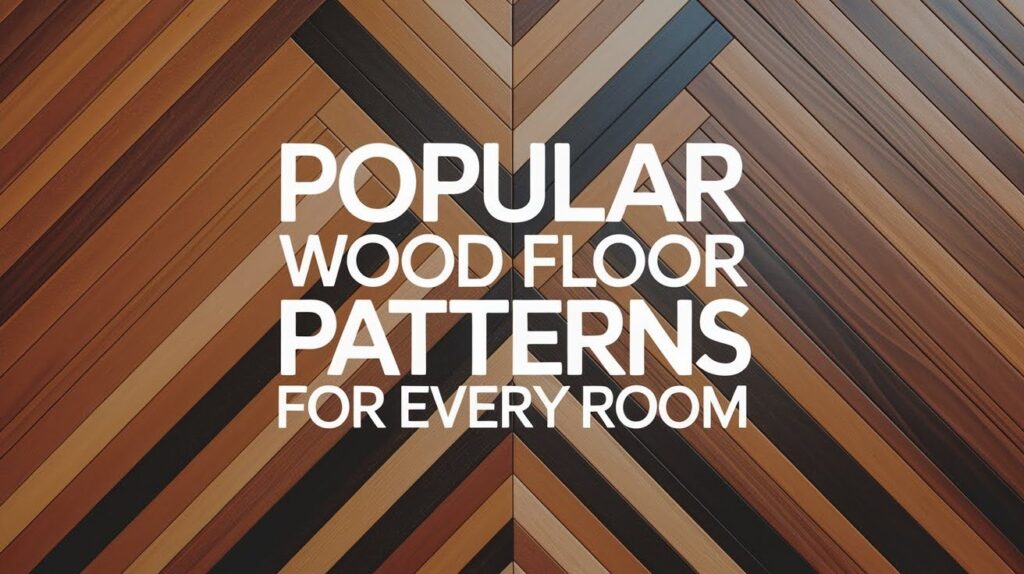Choosing the proper wood floor design may change a room’s look and feel. Your home’s style is matched with, a space’s size is affected by, and your property’s resale value can increase from the pattern you select.
I will walk all of you through 9 popular wood floor patterns. Their work is in varied places. You’ll learn which patterns widen narrow spaces as well as which suit modern or customary homes, plus how to pick the best for high-traffic areas.
This guide is one that covers the classic straight lay and herringbone. It also covers parquet and basketweave. We can locate the ideal floor for your residence.
Understanding Wood Floor Patterns
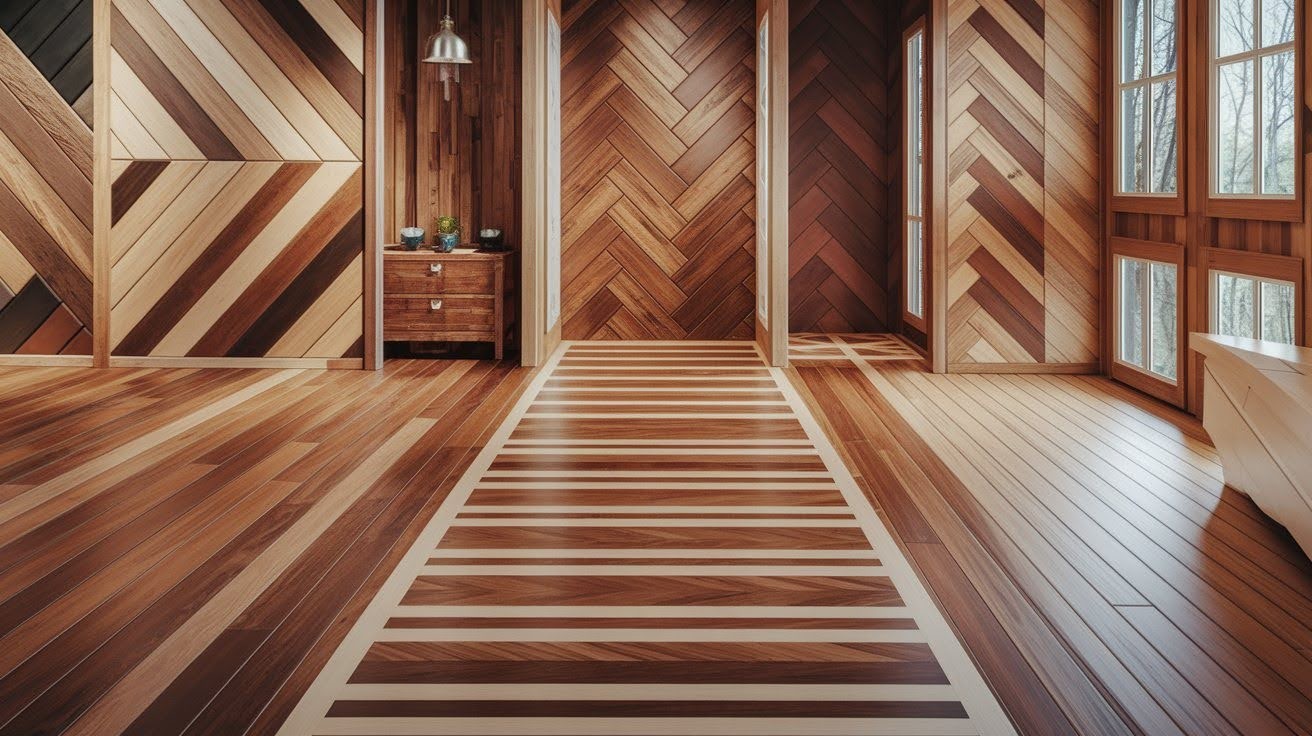
The pattern you choose for your wood floors changes how a room feels. Patterns can make spaces seem larger or cozier, formal or relaxed. Plank layouts like straight or diagonal are simple and versatile.
Geometric designs such as herringbone and chevron add visual interest. Decorative inlays turn your floor into a focal point.
The right pattern matches your home’s style and affects resale value. Diagonal lines can make narrow hallways feel wider.
Some patterns work better in large spaces, while others help small rooms feel bigger. Your flooring pattern is a long-term choice, so take time to pick the right one for your space.
List of 9 Popular Wood Floor Patterns
Here are nine flooring options that work in different spaces, from simple straight layouts to intricate custom designs for every style and budget.
1. Straight Pattern
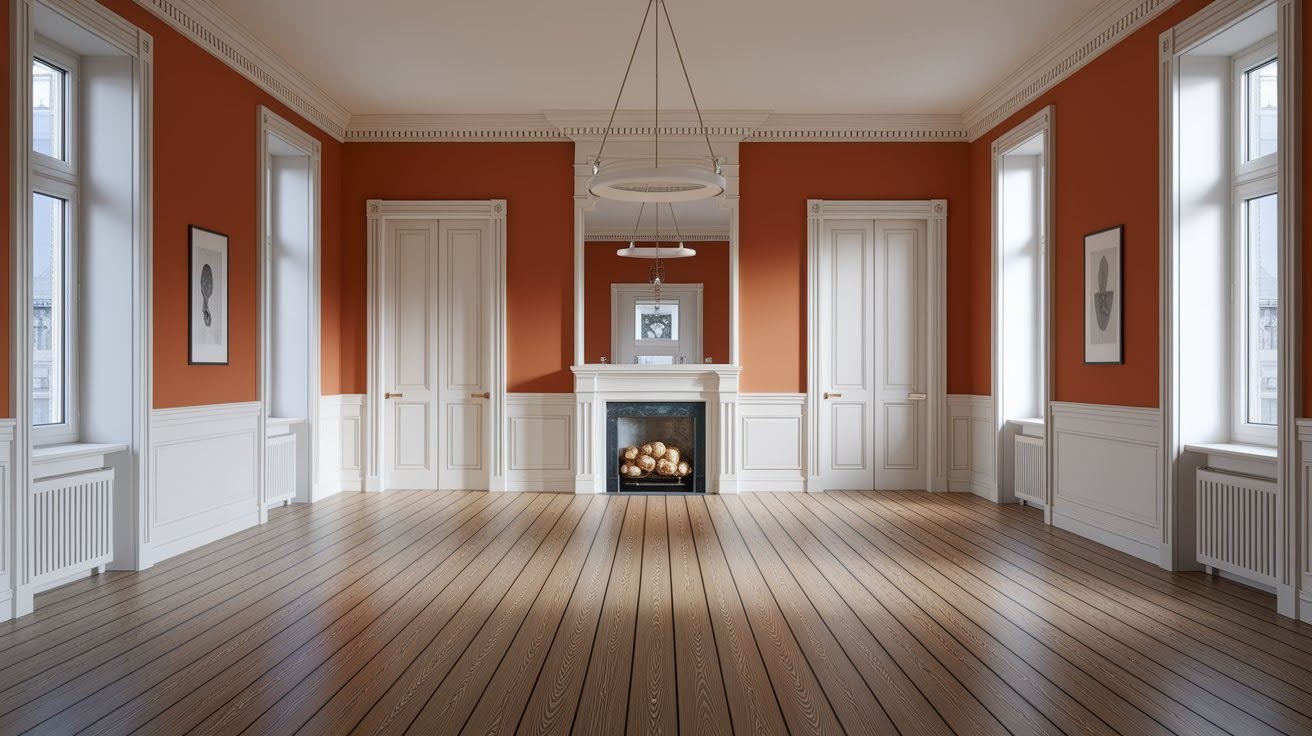
Description
The straight pattern is the most common wood flooring layout. Planks run end-to-end in one direction, either parallel or perpendicular to your longest wall. This creates a clean, linear look that never goes out of style.
Advantages
Installation is straightforward, which keeps costs down. This pattern works well with any interior style, from modern minimalist to traditional farmhouse. You can install it yourself if you have basic DIY skills.
Disadvantages
The simple design doesn’t create much visual interest. It can also make imperfections in your wood or room layout more noticeable. If your walls aren’t perfectly straight, this pattern will show it.
Best Applications
This pattern works in almost any room. Use it in living rooms, bedrooms, hallways, and kitchens. It’s particularly good for rental properties or spaces where you want the flooring to blend into the background.
2. Diagonal Pattern
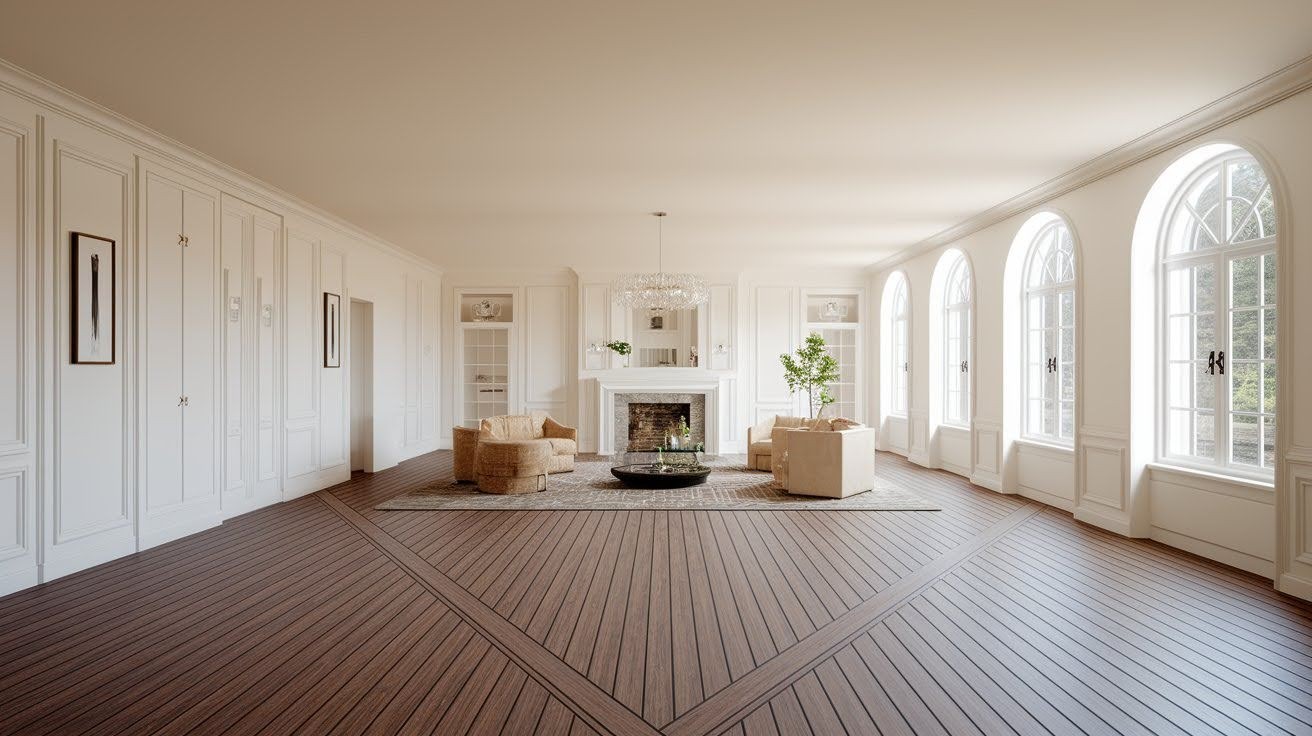
Description
Diagonal patterns place planks at a 45-degree angle to your walls. This creates a sense of movement and makes your floor more interesting to look at.
Advantages
Rooms appear larger when the flooring runs diagonally. The angled lines trick your eye into seeing more space. This pattern also stands out without being too bold.
Disadvantages
Installation takes more skill and time. You’ll waste more material because of the angled cuts at each wall. Expect to order 15-20% extra flooring.
Best Applications
Small or narrow rooms benefit most from this pattern. Try it in entryways, compact bathrooms, or open-concept spaces where you want to define different zones.
3. Herringbone Pattern
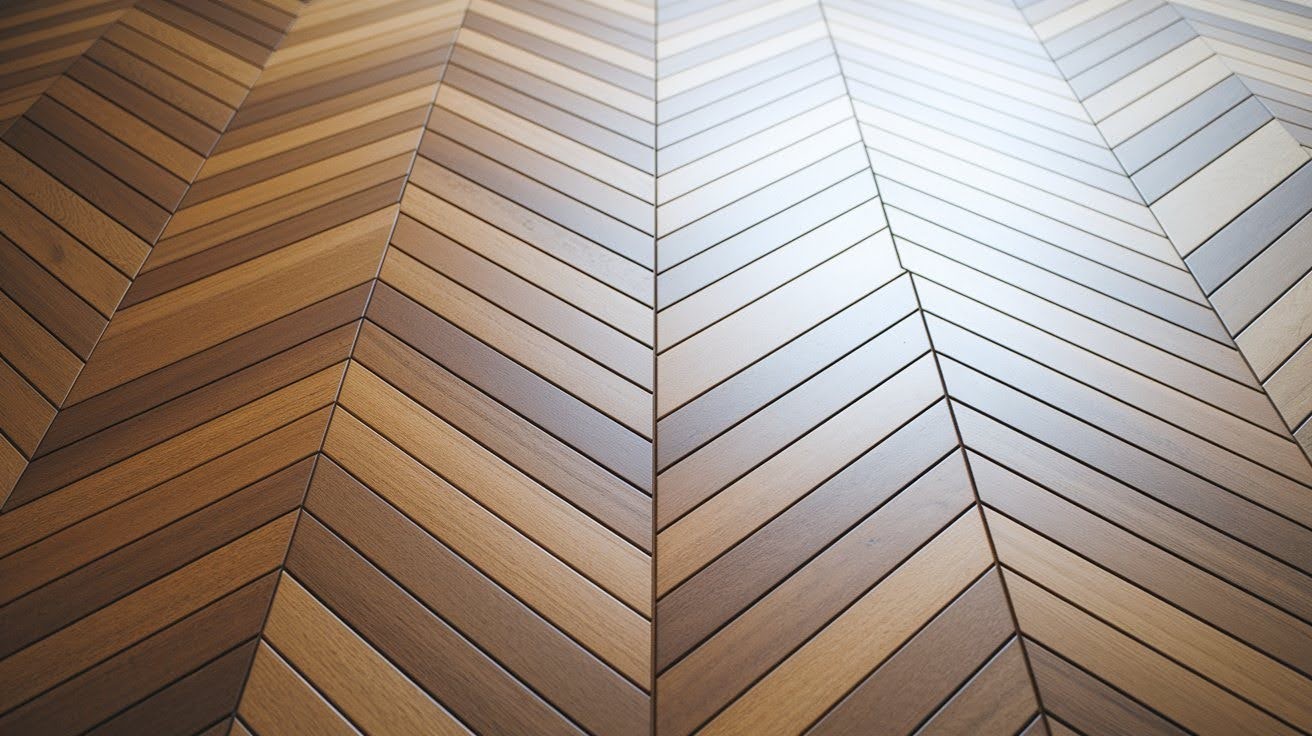
Description
Herringbone arranges rectangular planks in a zigzag formation. The planks meet at right angles, creating distinctive V-shapes that repeat across your floor.
Advantages
This classic pattern adds movement and depth to any space. It has been popular for centuries and still looks fresh today. The design draws the eye and makes rooms feel more expensive.
Disadvantages
Installation requires precision and takes significantly longer than straight patterns. Labor costs run higher, and you’ll need a skilled installer to get the angles right.
Best Applications
Large living rooms and dining rooms show off herringbone best. It also works beautifully in master bedrooms and wide hallways where people can appreciate the pattern.
4. Chevron Pattern
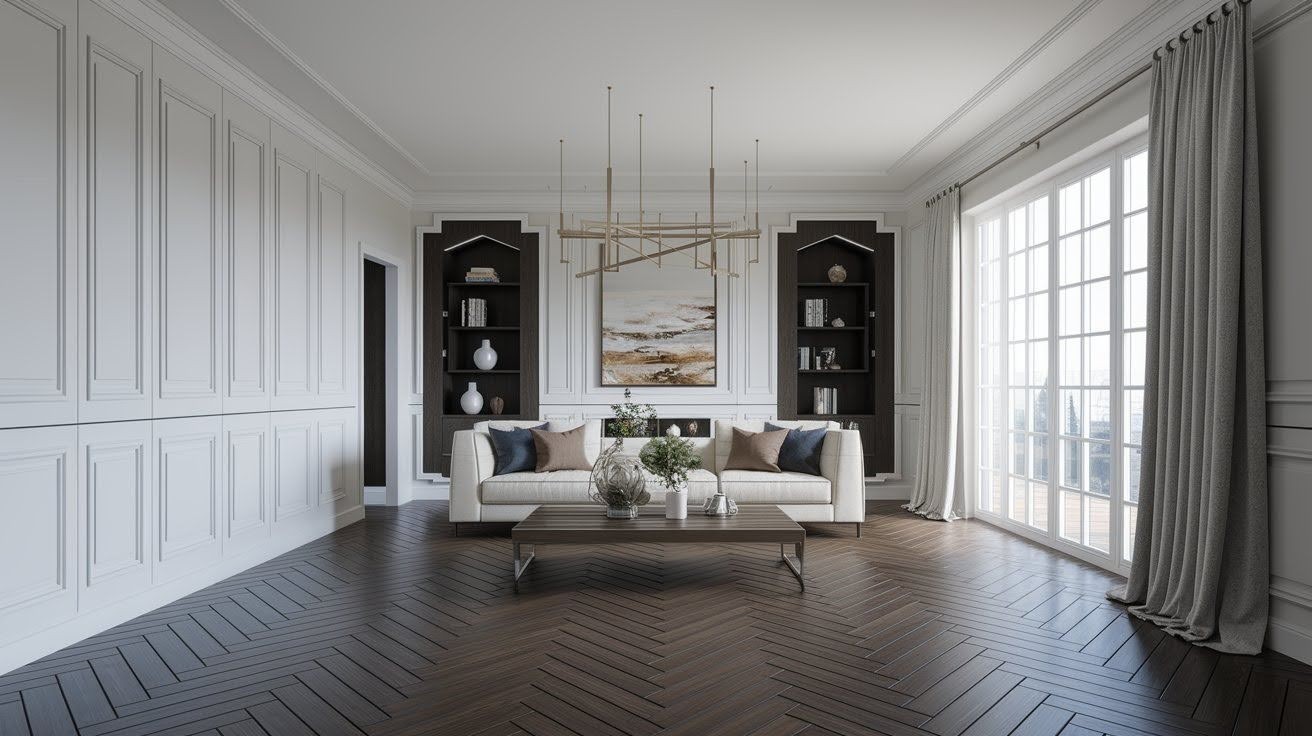
Description
Chevron looks similar to herringbone but creates continuous V-shapes. Each plank is cut at an angle so the ends meet in perfect points. This creates cleaner, more dramatic lines.
Advantages
The bold design makes a strong visual statement. You can orient the Vs to make rooms appear longer or wider, depending on your needs.
Disadvantages
This pattern requires professional installation. The angled cuts must be precise or the pattern won’t line up. Material costs run higher due to waste from cutting.
Best Applications
Living rooms, dining rooms, and primary bedrooms showcase chevron well. Entryways also benefit from this eye-catching pattern that greets guests with style.
5. Parquet Pattern
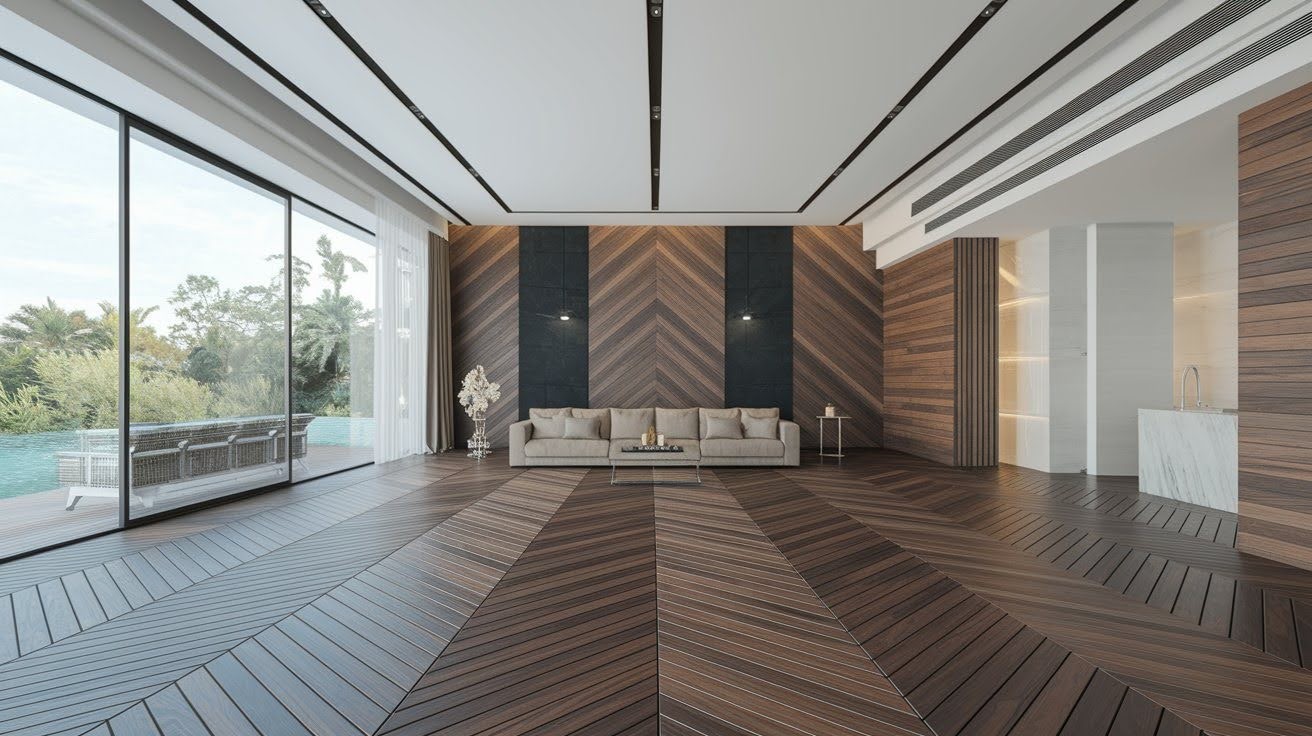
Description
Parquet uses small pieces of wood arranged in geometric designs. Common styles include basketweave, Versailles, and Monticello. Each creates intricate, repeating patterns across your floor.
Advantages
These designs look luxurious and detailed. You can customize the pattern to match your style. Parquet has a timeless quality that adds value to homes.
Disadvantages
Installation is expensive and slow. The small pieces take time to place correctly. Parquet also needs more maintenance and can be sensitive to moisture changes.
Best Applications
Formal living rooms and dining rooms suit parquet best. Grand entryways also benefit from these sophisticated patterns that make a memorable first impression.
6. Mixed-Width Pattern
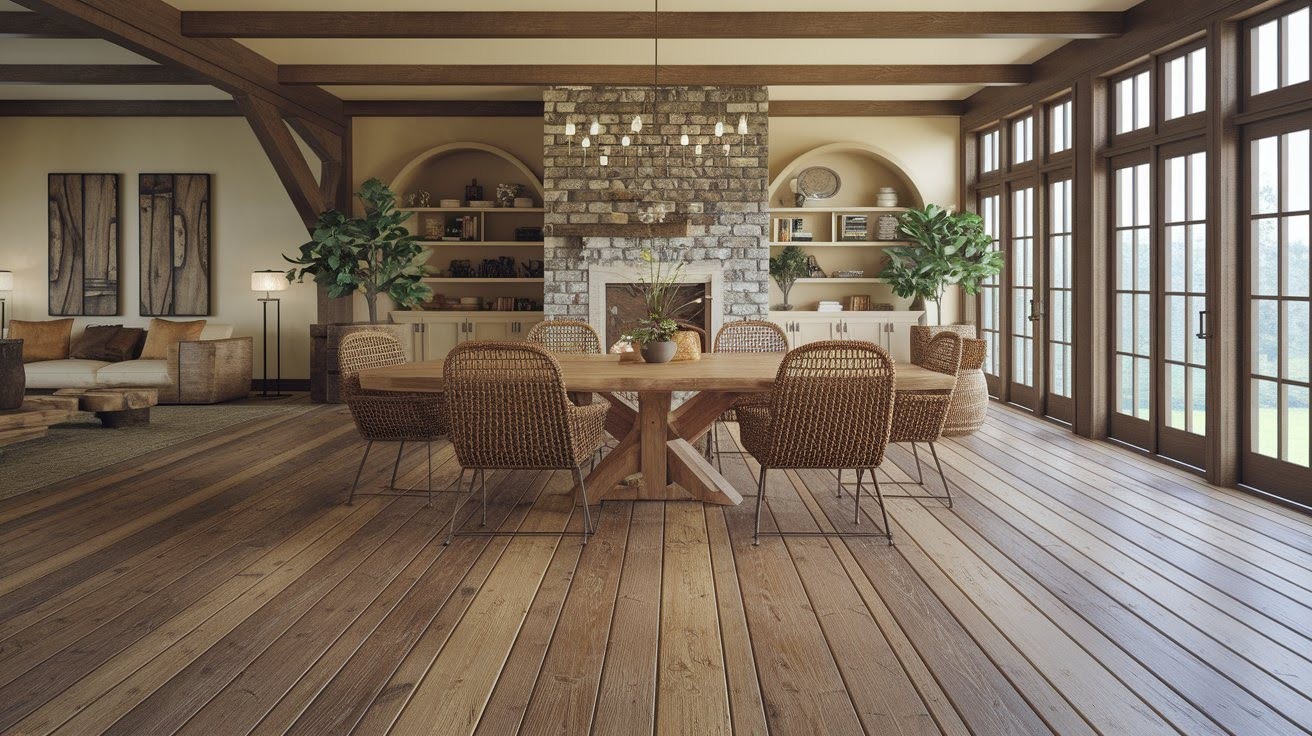
Description
This pattern combines planks of different widths in the same floor. You can arrange them randomly or in repeating sequences. The varied widths create visual texture.
Advantages
The look feels organic and natural. This pattern helps you use leftover materials efficiently. It adds character without complex installation techniques.
Disadvantages
Planning the layout takes extra thought. In small rooms, too much variation can make the space feel busy or chaotic.
Best Applications
Large rooms and open-concept spaces handle mixed widths well. This pattern also fits rustic or farmhouse interiors, where imperfection adds to the charm.
7. Floor Medallions
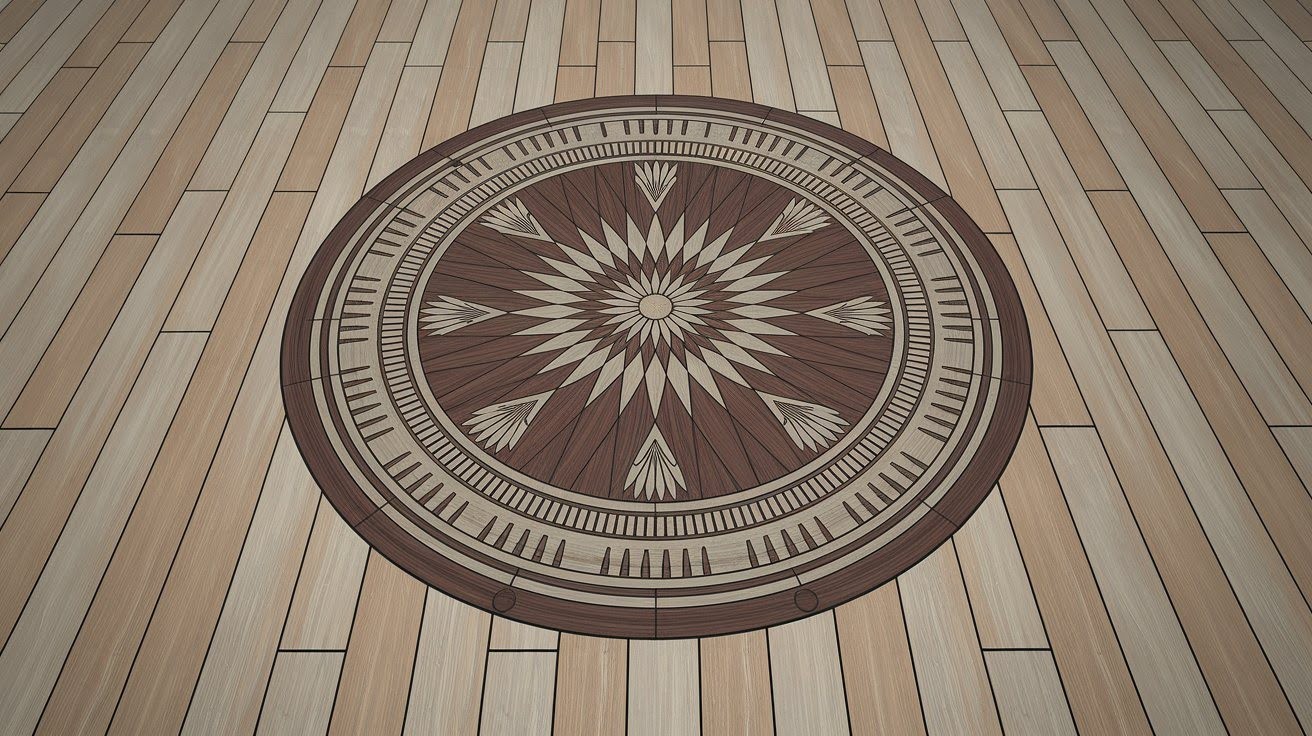
Description
Medallions are decorative centerpieces installed in your floor. They can stand alone or combine with parquet or straight patterns around them. Think of them as artwork for your floor.
Advantages
A medallion creates an instant focal point. You can customize the wood type, design, and size to match your space. They add refinement that sets your home apart.
Disadvantages
Quality medallions cost more than standard flooring. Installation requires an experienced professional who can integrate the piece seamlessly.
Best Applications
Entryways benefit most from medallions, they welcome guests with style. Formal living rooms and home offices also showcase these decorative elements well.
8. Floor Borders & Corners
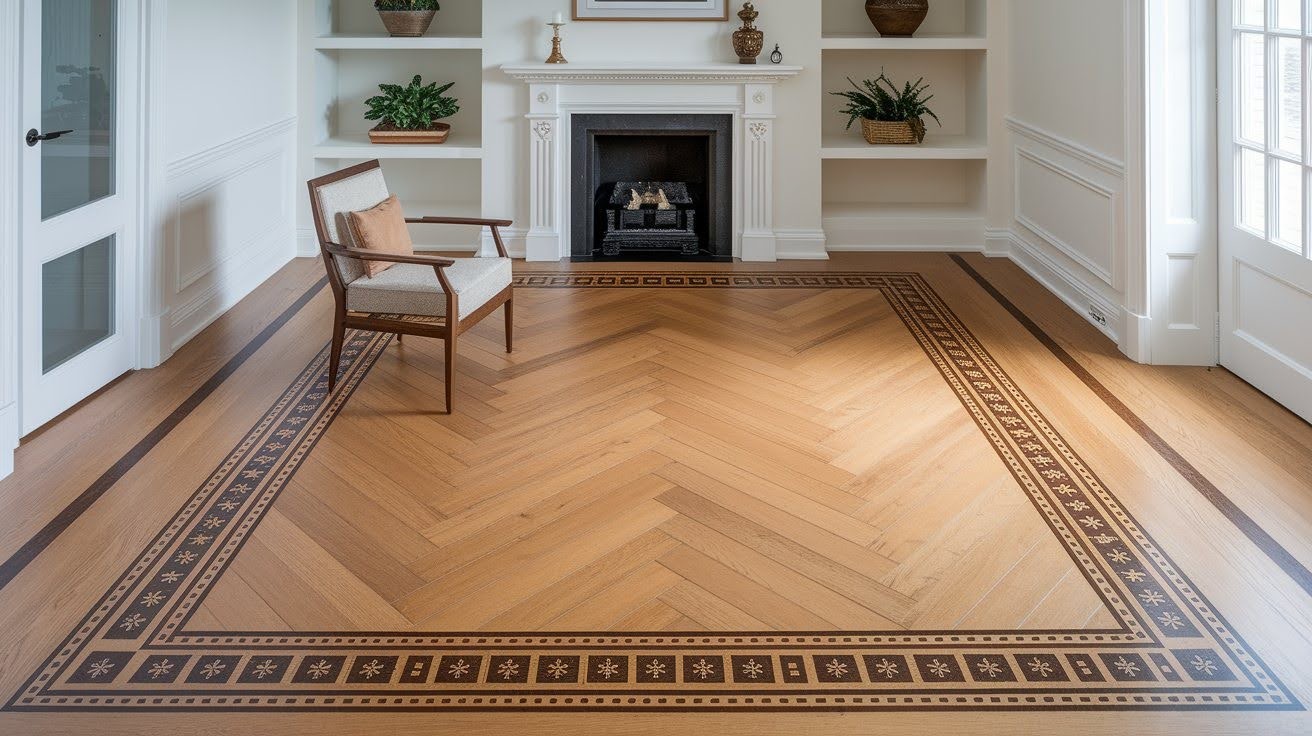
Description
Borders are decorative strips that frame a room or medallion. They run along walls or define specific areas. You can match them to your main flooring or choose contrasting wood.
Advantages
Borders add finishing details that make floors look complete. They can define spaces in open layouts or highlight architectural features.
Disadvantages
You’ll spend more on materials and installation. The extra detail requires precise measurements and cutting.
Best Applications
Dining rooms look polished with border details. Living rooms and hallways also benefit from these framing elements that add refinement.
9. Custom Inlay Patterns
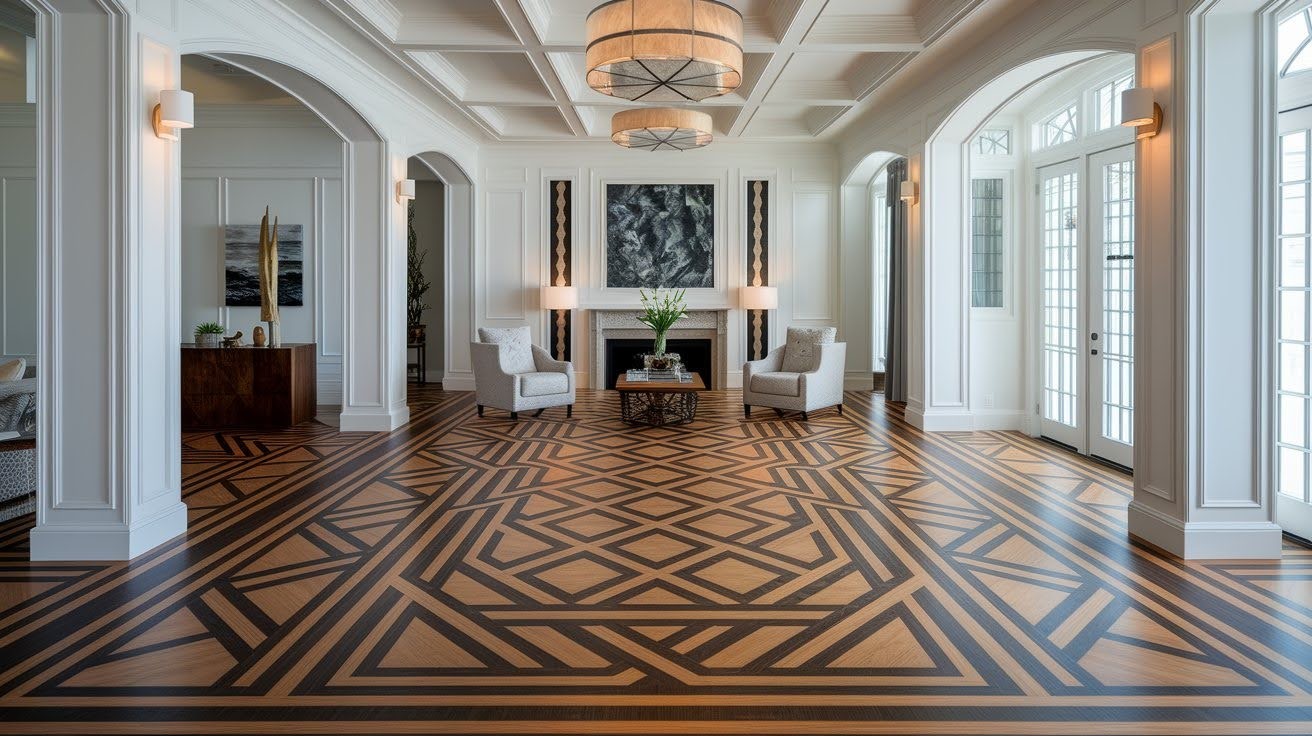
Description
Custom inlays are artistic or geometric designs created from multiple wood pieces. They’re built specifically for your room size and personal style preferences.
Advantages
Your floor becomes one-of-a-kind. These statement-making designs reflect your personality and can become conversation starters. The luxurious look adds significant character.
Disadvantages
Custom work is labor-intensive and expensive. You need a skilled craftsperson who specializes in this type of installation. Design and installation can take weeks.
Best Applications
Foyers and large living spaces give custom inlays room to shine. Use them in showpiece rooms where you want to make a lasting impression on visitors.
Tips for Choosing the Right Floor Pattern
- Look at your room’s dimensions and lighting: Small rooms need patterns that create space, while bright rooms can handle darker woods and busier designs.
- Match the pattern to your home’s style: Modern spaces suit straight or chevron patterns, while traditional homes work better with herringbone or parquet.
- Be realistic about your budget: Straight patterns cost less, but complex designs require professional installation and higher expenses.
- Think about maintenance: Intricate patterns collect more dirt, while simpler layouts are easier to clean in high-traffic areas.
- Test before you commit: Lay out sample boards in your room or use digital tools to see how patterns look in your space.
Conclusion
You now know all 9 wood floor patterns here for converting all of your rooms. Simple straight layouts as well as detailed parquet designs each offer their own different thing.
Each option alters your own home when you then install it. Consider the room’s size, preferred style, the budget, and the maintenance you will handle.
I wonder what design captured your interest. Do you prefer classic herringbone or are you considering a bold chevron?
Tell me why: drop a comment underneath. Are you ready now to start your flooring project?
In order to view all of these patterns within your actual space, be sure to consult with a professional installer. For seeing the patterns, online visualization tools are another option.
Frequently Asked Questions
What is the easiest wood floor pattern to install?
The straight pattern is the simplest to install and works well for DIY projects. It requires basic tools and skills, making it the most cost-effective option for homeowners on a budget.
Which wood floor pattern makes a small room look bigger?
Diagonal patterns are best for making small rooms appear larger. The angled planks create a visual flow that tricks the eye into perceiving more space than actually exists.
What’s the difference between herringbone and chevron patterns?
Herringbone planks meet at right angles, creating a broken zigzag, while chevron planks are cut at angles to form continuous V-shapes. Chevron appears more streamlined, but herringbone is easier to install.
How much more does a complex pattern cost compared to straight planks?
Complex patterns like parquet or chevron can cost 30-50% more than straight installations. This accounts for additional labor time, material waste, and the need for professional installation expertise.
Can I mix different wood floor patterns in one home?
Yes, you can use different patterns in separate rooms to define spaces. Just maintain consistency in wood tone and finish so the transitions feel intentional rather than random.

